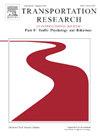Long-term is no term: A systematic review of learning effects and the understanding of “long-term” in the context of driver-vehicle interaction
IF 3.5
2区 工程技术
Q1 PSYCHOLOGY, APPLIED
Transportation Research Part F-Traffic Psychology and Behaviour
Pub Date : 2025-04-10
DOI:10.1016/j.trf.2025.03.027
引用次数: 0
Abstract
The appropriate usage of automated driving systems must be learned, with the learning process supposedly tied to the continuous engagement of the driver with the system. Despite extensive research on the short-term effects of automated driving systems, there is limited understanding of the long-term usage and the adaptation processes involved. This work addresses this gap through a systematic literature review focused on the effects of repeated or prolonged exposure to automated driving systems. In particular, the review aims to clarify definitions and theoretical constructs related to the long-term usage of driving systems, to provide recommendations for the methodological design of studies investigating learning and adaptation processes, and to synthesize existing findings on the effects of repeated exposure. A comprehensive literature research adhering to the PRISMA guidelines resulted in the review of 96 articles. The review emphasizes that other influencing factors, such as the sequence and quality of experienced events, play a crucial role in driver adaptation rather than the mere duration of exposure. Finally, a conceptual model of driver adaptation is developed, distinguishing between learning processes and temporary state adjustments and serving as a basis for exploring and comprehending the mechanisms and dynamics of such processes. This model highlights the need for future studies to adopt a more nuanced approach to “long-term” exposure, considering intermission periods and the influence of system capabilities, limits, and failures on the development of mental models. The paper concludes by offering recommendations for future research, stressing the importance of both behavioral and attitudinal adaptation.
长期不是术语:对驾驶员-车辆交互背景下的学习效果和对“长期”的理解的系统回顾
必须学会正确使用自动驾驶系统,而学习过程应该与驾驶员与系统的持续接触联系在一起。尽管对自动驾驶系统的短期影响进行了广泛的研究,但对长期使用和所涉及的适应过程的了解有限。这项工作通过系统的文献综述来解决这一差距,重点关注重复或长时间暴露于自动驾驶系统的影响。该综述旨在澄清与驾驶系统长期使用相关的定义和理论构建,为研究学习和适应过程的研究方法设计提供建议,并综合现有的关于重复暴露影响的研究结果。根据PRISMA指南进行了全面的文献研究,共审查了96篇文章。该综述强调,其他影响因素,如经历事件的顺序和质量,在驾驶员适应中发挥关键作用,而不仅仅是暴露时间的长短。最后,建立了驾驶员适应的概念模型,区分了学习过程和临时状态调整,并作为探索和理解这些过程的机制和动力学的基础。该模型强调了未来研究需要采用更细致入微的方法来研究“长期”暴露,考虑间歇期和系统能力、限制和失败对心智模型发展的影响。文章最后对未来的研究提出了建议,强调了行为适应和态度适应的重要性。
本文章由计算机程序翻译,如有差异,请以英文原文为准。
求助全文
约1分钟内获得全文
求助全文
来源期刊
CiteScore
7.60
自引率
14.60%
发文量
239
审稿时长
71 days
期刊介绍:
Transportation Research Part F: Traffic Psychology and Behaviour focuses on the behavioural and psychological aspects of traffic and transport. The aim of the journal is to enhance theory development, improve the quality of empirical studies and to stimulate the application of research findings in practice. TRF provides a focus and a means of communication for the considerable amount of research activities that are now being carried out in this field. The journal provides a forum for transportation researchers, psychologists, ergonomists, engineers and policy-makers with an interest in traffic and transport psychology.

 求助内容:
求助内容: 应助结果提醒方式:
应助结果提醒方式:


